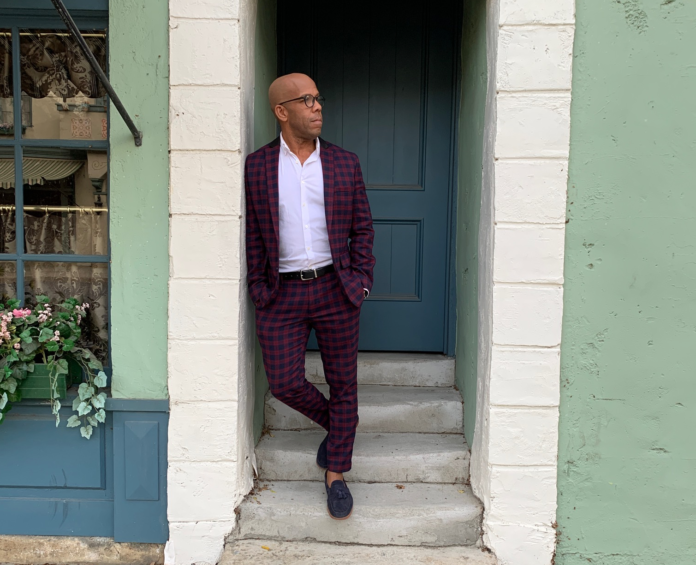How local designer Ken Wingard found his community and grew his business.
by Maureen Futtner
San Francisco–based designer Ken Wingard rakes through various ephemera at a local flea market. He inspects a tattered old suitcase destined for the garbage heap and envisions an elegant Old World–style side table. It’s a variation on a scene Wingard has played out countless times over the years, whether the objects were iron pipes, mason jars, or vintage footballs. Armed with unrelenting optimism and a hot glue gun, 55-year-old Wingard has a way of cutting diamonds from the rough.
As a gay Black man, owner of a brick-and-mortar shop in the Castro, and an engaged citizen advocating for a better San Francisco, Wingard has always seen potential where others see barriers. And that positive attitude has delivered him great success.
Wingard is an entrepreneur who cut his teeth in retail as divisional director at Pottery Barn. He has designed home furnishings for high-profile retailers such as Crate & Barrel and Target. Museum shops, including those of SFMOMA and New York’s MoMA, have carried Wingard’s vases, candleholders, frames, and lamps.
And then there is Ken Wingard the TV personality. After several seasons as on-camera designer for the Oprah Winfrey Network’s “Home Made Simple” reality show, Wingard is in his ninth season as a “family member” of the Hallmark Channel’s Emmy-nominated “Home & Family.”
The program’s lighthearted banter is a perfect showcase for Wingard’s sunny outlook and talent for craft. He wows his fellow cast members with his quirky DIY designs that turn out perfectly. Floral wire, burlap, twigs, and a papier-mâché bird transform into a wreath to celebrate spring. Rusted kitchen utensils mounted on a wood board become an affordable work of art.
“I’ve just always been a glass-half-full kind of guy,” Wingard said.
This Must Be The Place
In 1989, the Bay Area was Wingard’s last stop on a post-college backpacking adventure that began in New York City, took him around the world, and finally landed him in San Francisco.
“There was a somberness to the city and I was just coming out at that point. So it was a very reflective time. It was also an odd time because when we would go out, everybody was the same age. You wouldn’t see people over the age of 22 or 23, because they were ill or dying.”
Not only was AIDS ravaging the city, but a massive earthquake earlier that year had taken lives and destroyed vast swaths of property. Nevertheless, Wingard remembered, “Even with all the tragedies, the sadness, I felt like I was home for the first time in my life.”
On his first day, he “took a little meander one afternoon to the Lower Haight and it was like the clouds parted,” he said. “I found my people.”
The community Wingard encountered was not tied strictly to identity but rather to a collective ethos. “To me, it was this bohemian, Lower Haight/Mission sort of people that were not driven by money and power but by the arts and writing and being weird,” he said. “Everyone was just being their own person, which I never had growing up.”
Wingard’s upbringing in a military family might seem antithetical to the free-spirited lifestyle celebrated among San Franciscans. Couple that with his education at a buttoned-down Ivy League school—he holds a bachelor’s degree from Princeton—and you might wonder how he was so open to embracing our city’s Left Coast culture.
It turns out, Wingard’s creativity was nurtured from a young age. “I grew up in that sort of poor southern African-American tradition,” he recalled. “My grandmother made everything. If you wanted something, there was no money to buy it, so you had to make it.”
Born in Savannah, Georgia, he spent his formative years in Williamsburg, Virginia. “It was right in the middle of that whole traditional Americana thing that Williamsburg had going on,” he said. “I did punch-needling and crocheting. I made corn husk dolls. I learned fabric weaving, all these sorts of early-American crafts.”
He watched his mother create plant arrangements and make ceramics and his grandmother sew clothes. So it was no surprise when 10-year-old Wingard declared he wanted to attend “crafts camp.”
“By fifth grade, my dad built me my own craft room,” he said. “He built the cabinets and got me all the tools. I would spend every day after school and all weekend in there by myself, just making things.”
Up the Ladder of Success
One of Wingard’s first jobs in San Francisco was answering phones for Pottery Barn. The upscale home furnishings store had just been purchased by Williams Sonoma. Under Chuck Williams’ leadership in the early ’90s, Pottery Barn was in growth mode.
“Back then, Pottery Barn very much had this sort of grassroots feel to it,” Wingard said. When he joined the company, it had 22 stores. Eight years later, there were over a hundred stores and Wingard was buying accessories for half of them, traveling globally to set the Pottery Barn style for the following year.
“I moved my way up there. At the point when I ended up being director, there were just three of us that were sort of designing and running the company. And we were having fun. We were creating things and letting our creative juices flow and coming up with wacky, weird design elements.”
And yet, the inevitable corollary of growth in business is corporatization. As Pottery Barn expanded and became more rigid, Wingard got itchy feet. He left the company in search of another outlet for his creative talents.
At 33, he started Wingard, Inc., a home accessories wholesale business, and his brand took off from there. His designs were picked up by Restoration Hardware and Martha Stewart. In Style magazine featured his high-heel-red mobiles. His black fetish vases graced the pages of O, The Oprah Magazine. And a New York Times design writer accompanied Wingard on a shopping trip for essential ladders for the home.
Civic Duty
As Wingard’s business grew, so too did his desire to engage in his community. As a past member of the Market and Octavia Citizens Advisory Committee, Wingard helped to steer the neighborhood plan toward increasing affordable housing and mitigating displacement.
“I wanted to make sure that as a gay man and as a minority, our voices were heard,” he said.
Of particular concern to Wingard is his beloved city’s waning diversity, particularly its decreasing Black population, which is now less than half of what it was when Wingard moved to San Francisco.
“You know, raising three mixed-race children, I feel it’s important that we maintain that diversity, both from a racially diverse point of view and a socioeconomic diversity point of view. It’s one of the things that has always made San Francisco special.”
It is one of the reasons, he said, that he is committed to sending his children to public school. “That diversity, it still exists. One just has to make a conscious effort to engage it and to find it, which is a shame,” he said.
Wingard laughed as he told me about his reaction to the 2019 film “The Last Black Man in San Francisco.” He said, “I saw that movie and thought, no, no, no. I’m the last Black man!”
Kenneth Wingard, The Boutique
The first incarnation of Wingard’s shop in Polk Gulch would these days be called a pop-up. Wingard and the designers he shared space with needed to sell off extra inventory after the holidays. They opened their warehouse door and welcomed the public in for a party with shopping. The event was a hit.
That first studio-turned-shop led to a brief lease in the Marina and, after that, the Kenneth Wingard boutique, which opened on Market Street in the Castro in 2006.
A tribute to affordable chic, the shop reflects Wingard’s affinity for the wacky and wonderful in home accessories: retro clocks, dazzlingly shiny mobiles, a cozy sofa, whimsical flower vases, fun and funky décor, gentlemen’s grooming products, even novelty keychains. In the shop’s early days, you might have gotten a chance to meet the designer himself. Nowadays Wingard employs a team of five to work the storefront.
Of course, that was beforetimes. I interviewed Wingard in late April 2020, deep into the stay-at-home order and at the beginning of our new post-COVID world. Had it been pre-pandemic, could I have secured an interview with the in-demand TV personality? Perhaps not. These days, Wingard’s calendar has cleared a bit.
As coronavirus cases fluctuate nationwide, the future of small businesses grows increasingly uncertain. High rent combined with an unpredictable reopening schedule has forced many local shops to close. For San Francisco, which prides itself on its antichain legislation and unique neighborhood shops, this latest blow to brick-and-mortar retail is an existential threat to the city’s treasured local character.
And now the future of the Kenneth Wingard boutique hangs in the balance. The quirky shop that has been a fixture of the Castro is awaiting the next moves of its new landlord. Just one month prior to shelter-in-place, the building that houses the store and four other businesses was sold by the family that had owned it for decades.
What does that mean for Wingard’s store? His characteristic optimism shined through as he noted how the city’s resilience is one of its defining characteristics. “We’ll get through it all. I just want everyone to be conscious of what we have here in San Francisco. We need to nurture that San Francisco spirit, to keep it alive.” ♦
Maureen Futtner has been a communications professional in San Francisco for 20 years. When not interviewing remarkable people, she loves to play music with her wife and enjoy sunset views of Sutro Tower from their home in the Mission.



